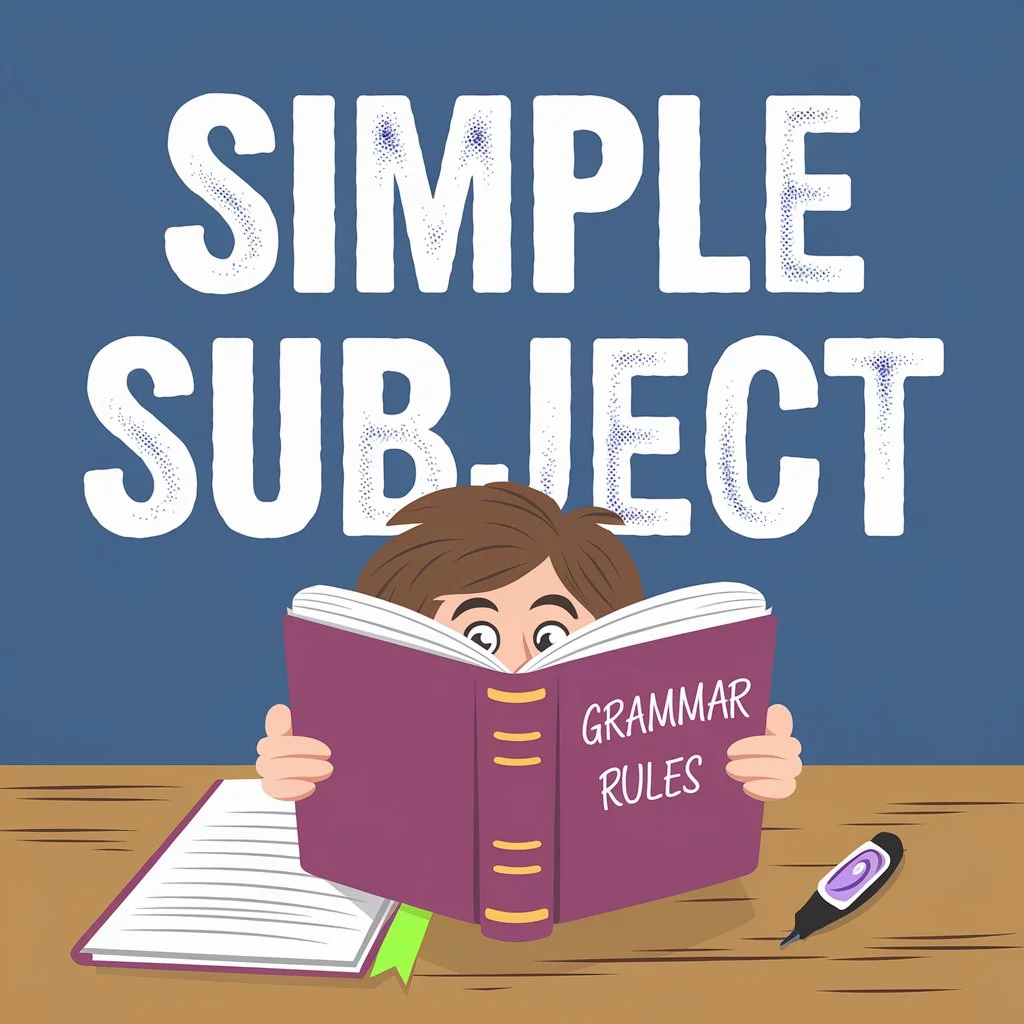When we talk about sentences, we need to understand that each one has a subject. The simple subject is the most basic part of the subject—the main noun or pronoun that tells us who or what the sentence is about. For example, in the sentence, “The dog barks,” the simple subject is “dog” because it’s the word that tells us who is doing the action.
The simple subject is different from the complete subject. While the complete subject might include all the words that describe the subject (like “the tall dog”), the simple subject is just the main noun or pronoun. Understanding this difference is key to writing clear, correct sentences.
Example of a Simple Subject
Let’s take this sentence: The big, furry cat sleeps all day.
- The simple subject is “cat.”
- The complete subject is “The big, furry cat.”
As you can see, the simple subject is just one word, but the complete subject includes all the descriptive words.
Why Is the Simple Subject Important?
Understanding the simple subject helps you grasp the structure of a sentence, which is important for clear writing. When you know the subject of a sentence, you can easily understand who or what is performing the action. This makes your sentences more understandable to readers and keeps your writing on point.
Clearer Sentences
By knowing the simple subject, you can avoid run-on sentences or fragments. A sentence without a clear subject can confuse readers, and you want your writing to be as clear as possible. For example, if I said, “Runs quickly,” you might wonder who is running. But if I say, “The boy runs quickly,” the simple subject “boy” makes everything clear.
Better Subject-Verb Agreement
Knowing the simple subject also helps you with subject-verb agreement. This means making sure the verb matches the subject in number (singular or plural). For example:
- The dog runs.
- The dogs run.
In the first sentence, “dog” is singular, so the verb “runs” matches. In the second sentence, “dogs” is plural, so the verb “run” is used. Misunderstanding this can lead to mistakes in your writing, so it’s important to get it right!
How to Identify a Simple Subject
Identifying a simple subject is easy once you know what to look for. The simple subject is the main noun or pronoun that tells you who or what is doing the action in the sentence. A quick way to find it is to ask, who or what is the sentence about?
Step-by-Step Guide
Follow these simple steps to identify the simple subject:
- Find the verb: Look for the action or state of being word (e.g., run, jump, is, are).
- Ask “who” or “what”: Ask yourself, who or what is doing the action or being something in the sentence?
- Identify the noun or pronoun: The answer to your question will be the simple subject.
Examples
Let’s try a few examples to practice:
- The teacher explains the lesson.
- Verb: explains
- Who or what explains? Teacher
- Simple subject: teacher
- The bright stars twinkle in the sky.
- Verb: twinkle
- Who or what twinkle? Stars
- Simple subject: stars
It’s that simple! Just find the verb and ask who or what is doing the action.
Simple Subject vs. Complete Subject
Now that we know what a simple subject is, let’s compare it to a complete subject. While the simple subject is just the main noun or pronoun, the complete subject includes the simple subject and all the words that modify or describe it.
The Difference Explained
- Simple subject: The one word that tells us who or what is doing the action.
- Complete subject: The simple subject plus any descriptive words or phrases.
For example: The friendly dog barked loudly.
- The simple subject is “dog.”
- The complete subject is “The friendly dog.”
As you can see, the complete subject includes both the simple subject (“dog”) and the adjectives that describe the dog (“the friendly”). Understanding the difference helps you see how a sentence is built and how different parts work together.
Common Mistakes When Identifying Simple Subjects
Even though identifying a simple subject seems easy, there are common mistakes students often make. Let’s look at some of these mistakes and how to avoid them.
Mistake 1: Confusing Adjectives with the Simple Subject
One of the most common mistakes is thinking that adjectives (words that describe a noun) are part of the simple subject. Remember, adjectives belong to the complete subject, not the simple subject.
For example: The tall, strong athlete ran the race.
- Simple subject: athlete
- The words “tall” and “strong” are just descriptions. They are part of the complete subject, but not the simple subject.
Mistake 2: Ignoring Plural and Collective Nouns
Another common mistake is not paying attention to plural nouns or collective nouns. When you have more than one subject, or when the subject represents a group, the simple subject can still be tricky to spot.
For example:
- The players on the team are practicing.
- Simple subject: players (plural)
- The team is practicing.
- Simple subject: team (collective noun)
Notice how even though “players” and “team” both refer to groups, the simple subject changes based on how the sentence is structured.
Mistake 3: Misunderstanding Compound Subjects
A compound subject is when two or more subjects are connected by a conjunction (like “and” or “or”). People sometimes think the compound subject is one word, but it’s actually both nouns.
For example: Jane and John are going to the park.
- Simple subject: Jane, John (compound subject)
Both “Jane” and “John” are doing the action, so both are part of the simple subject.
Simple Subject in Different Sentence Types
The simple subject can appear in different kinds of sentences, and it’s important to know how to spot it no matter the sentence type. Let’s explore how the simple subject looks in some common sentence types.
Declarative Sentences (Statements)
A declarative sentence is a statement that tells you something. In these sentences, the simple subject is usually easy to spot.
Example: The car drives fast.
- Simple subject: car
Interrogative Sentences (Questions)
In a question, the simple subject can be trickier to find because the sentence structure is different.
Example: Who is coming to the party?
- Simple subject: who (the person doing the action)
Imperative Sentences (Commands)
In imperative sentences, the simple subject is often implied. The subject is understood to be “you,” even though it’s not directly stated.
Example: Close the door.
- Simple subject: you (understood)
Understanding how the simple subject works in different sentence types helps you identify it no matter the sentence.
Simple Subject and Subject-Verb Agreement
Subject-verb agreement is a grammar rule that says the verb must match the subject in number. This means if the simple subject is singular, the verb must be singular. If the simple subject is plural, the verb must be plural.
Examples
- Singular: The cat runs fast.
- Simple subject: cat
- Verb: runs (singular)
- Plural: The cats run fast.
- Simple subject: cats
- Verb: run (plural)
When you understand the simple subject, it’s easy to make sure your verbs agree with your subjects, which is important for good grammar!
Common Mistakes in Subject-Verb Agreement
One common mistake is using a singular verb with a plural subject or vice versa. This happens when the simple subject is misunderstood. For example:
- The group of students is going on a trip.
- Simple subject: group (not students)
- Since “group” is singular, the verb should be singular: “is.”
Paying attention to the simple subject helps you avoid these errors.
Fun Activities to Practice Identifying Simple Subjects
Learning grammar doesn’t have to be boring! Let’s explore some fun activities to help you practice identifying the simple subject in sentences.
Activity 1: Sentence Sort
Write down a bunch of sentences on index cards. Cut each sentence in half, separating the simple subject from the rest of the sentence. Then mix up the cards and try to match the simple subject with its verb. This is a fun way to practice!
Activity 2: Underline the Simple Subject
Take a book or article and underline the simple subjects in different sentences. You can even challenge a friend to see who can spot the most simple subjects.
Activity 3: Create Your Own Sentences
Write five sentences of your own and then circle the simple subject in each one. This activity helps you practice both writing and identifying subjects.
These activities will make learning about simple subjects fun and easy!
FAQs
What is an infinitive phrase?
An infinitive phrase starts with an infinitive verb (the base form of a verb with “to”) and includes other words to complete its meaning. For example, “to run quickly” is an infinitive phrase. It can act as a noun, adjective, or adverb in a sentence
How do I identify an infinitive phrase in a sentence?
To find an infinitive phrase, look for the word “to” followed by a verb and extra words that complete the idea. For example, in the sentence “She loves to sing beautifully,” the phrase “to sing beautifully” is the infinitive phrase. It can describe actions or serve as a subject or object.
Can an infinitive phrase be used as a noun?
Yes, an infinitive phrase can act as a noun in a sentence. For example, in “To learn is important,” the infinitive phrase “to learn” is the subject of the sentence. It shows the action or thing being talked about.
What’s the difference between an infinitive and a gerund?
An infinitive is the base form of a verb with “to,” like “to run,” while a gerund is the -ing form of a verb, like “running.” Infinitives can act as nouns, adjectives, or adverbs, but gerunds only act as nouns. For example, “To swim is fun” (infinitive) vs. “Swimming is fun” (gerund).
Can infinitive phrases be split?
It’s best to avoid splitting an infinitive, which happens when you place a word between “to” and the verb. For example, “to quickly run” is a split infinitive, and it’s better to say “to run quickly.” Keeping the infinitive together makes your writing smoother.
Conclusion
The simple subject is one of the most important parts of a sentence because it tells you who or what is doing the action. By understanding how to identify the simple subject, you can write clearer, stronger sentences. Remember:
- The simple subject is just the main noun or pronoun.
- It’s different from the complete subject, which includes descriptions.
- Identifying the simple subject helps with subject-verb agreement.

It’s Elara Winters, your guide at “Grammer Grove.” I’ve dived into the intricacies of crafting the perfect English writing sections for your project, research paper, or thesis. With a wealth of experience in this field, I’m here to help you express gratitude and appreciation effectively. Join me on this journey, and let’s make your English writings shine!












